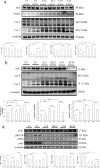Exercise training enhanced SIRT1 longevity signaling replaces the IGF1 survival pathway to attenuate aging-induced rat heart apoptosis
- PMID: 25148910
- PMCID: PMC4453937
- DOI: 10.1007/s11357-014-9706-4
Exercise training enhanced SIRT1 longevity signaling replaces the IGF1 survival pathway to attenuate aging-induced rat heart apoptosis
Abstract
Cardiovascular disease is the second leading cause of death (9.1 %) in Taiwan. Heart function deteriorates with age at a rate of 1 % per year. As society ages, we must study the serious problem of cardiovascular disease. SIRT1 regulates important cellular processes, including anti-apoptosis, neuronal protection, cellular senescence, aging, and longevity. In our previous studies, rats with obesity, high blood pressure, and diabetes exhibiting slowed myocardial performance and induced cell apoptosis were reversed via sports training through IGF1 survival signaling compensation. This study designed a set of experiments with rats, in aging and exercise groups, to identify changes in myocardial cell signaling transduction pathways. Three groups of three different aged rats, 3, 12, and 18 months old, were randomly divided into aging groups (C3, A12, and A18) and exercise groups (E3, AE12, and AE18). The exercise training consisted of swimming five times a week with gradual increases from the first week from 20 to 60 min for 12 weeks. After the sports training process was completed, tissue sections were taken to observe cell organization (hematoxylin and eosin (H&E) stain) and apoptosis (terminal deoxynucleotidyl transferase dUTP nick end labeling (TUNEL) assays) and to observe any changes in the myocardial tissues and proteins (Western blotting). The experimental results show that cardiomyocyte apoptotic pathway protein expression increased with age in the aging groups (C3, A12, and A18), with improvement in the exercise group (E3, AE12, and AE18). However, the expression of the pro-survival p-Akt protein decreased significantly with age and reduced performance. The IGF1R/PI3K/Akt survival pathway in the heart of young rats can indeed be increased through exercise training. As rats age, this pathway loses its original function, even with increasing upstream IGF1. However, levels of SIRT1 and its downstream target PGC-1α were found to increase with age and compensatory performance. Moreover, exercise training enhanced the SIRT longevity pathway compensation instead of IGF1 survival signaling to improve cardiomyocyte survival.
Figures





Similar articles
-
Moderate exercise training attenuates aging-induced cardiac inflammation, hypertrophy and fibrosis injuries of rat hearts.Oncotarget. 2015 Nov 3;6(34):35383-94. doi: 10.18632/oncotarget.6168. Oncotarget. 2015. PMID: 26496028 Free PMC article.
-
Resveratrol enhanced FOXO3 phosphorylation via synergetic activation of SIRT1 and PI3K/Akt signaling to improve the effects of exercise in elderly rat hearts.Age (Dordr). 2014;36(5):9705. doi: 10.1007/s11357-014-9705-5. Epub 2014 Aug 27. Age (Dordr). 2014. PMID: 25158994 Free PMC article.
-
Swimming exercise stimulates IGF1/ PI3K/Akt and AMPK/SIRT1/PGC1α survival signaling to suppress apoptosis and inflammation in aging hippocampus.Aging (Albany NY). 2020 Apr 22;12(8):6852-6864. doi: 10.18632/aging.103046. Epub 2020 Apr 22. Aging (Albany NY). 2020. PMID: 32320382 Free PMC article.
-
The IGF1-PI3K-Akt Signaling Pathway in Mediating Exercise-Induced Cardiac Hypertrophy and Protection.Adv Exp Med Biol. 2017;1000:187-210. doi: 10.1007/978-981-10-4304-8_12. Adv Exp Med Biol. 2017. PMID: 29098623 Review.
-
Longevity Pathways (mTOR, SIRT, Insulin/IGF-1) as Key Modulatory Targets on Aging and Neurodegeneration.Curr Top Med Chem. 2015;15(21):2116-38. doi: 10.2174/1568026615666150610125715. Curr Top Med Chem. 2015. PMID: 26059361 Review.
Cited by
-
The Protective Effects of Clams on Hypercholesterolemia in Late-Stage Triple-Transgenic Alzheimer's Diseased Mice Hearts.Mar Drugs. 2018 Aug 1;16(8):263. doi: 10.3390/md16080263. Mar Drugs. 2018. PMID: 30071640 Free PMC article.
-
Exercise training reverses cardiac aging phenotypes associated with heart failure with preserved ejection fraction in male mice.Aging Cell. 2020 Jun;19(6):e13159. doi: 10.1111/acel.13159. Epub 2020 May 22. Aging Cell. 2020. PMID: 32441410 Free PMC article.
-
Treadmill Exercise Attenuates α-Synuclein Levels by Promoting Mitochondrial Function and Autophagy Possibly via SIRT1 in the Chronic MPTP/P-Induced Mouse Model of Parkinson's Disease.Neurotox Res. 2017 Oct;32(3):473-486. doi: 10.1007/s12640-017-9770-5. Epub 2017 Jun 27. Neurotox Res. 2017. PMID: 28656548
-
Physical Exercise Inhibits Inflammation and Microglial Activation.Cells. 2019 Jul 9;8(7):691. doi: 10.3390/cells8070691. Cells. 2019. PMID: 31324021 Free PMC article. Review.
-
Moderate exercise training attenuates aging-induced cardiac inflammation, hypertrophy and fibrosis injuries of rat hearts.Oncotarget. 2015 Nov 3;6(34):35383-94. doi: 10.18632/oncotarget.6168. Oncotarget. 2015. PMID: 26496028 Free PMC article.
References
Publication types
MeSH terms
Substances
LinkOut - more resources
Full Text Sources
Other Literature Sources
Medical
Research Materials
Miscellaneous
